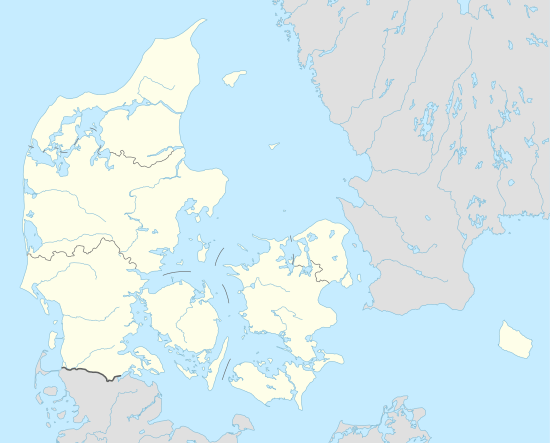Aalborg station
Aalborg railway station (Danish: Aalborg Station or Aalborg Banegård) is the main railway station serving the city of Aalborg, Denmark.
Aalborg station Aalborg Banegård | ||||||||||||||||||||||||||||||
|---|---|---|---|---|---|---|---|---|---|---|---|---|---|---|---|---|---|---|---|---|---|---|---|---|---|---|---|---|---|---|
| railway station | ||||||||||||||||||||||||||||||
 Front facade of Aalborg station viewed from J. F. Kennedy Square | ||||||||||||||||||||||||||||||
| Location | John F. Kennedys Plads DK-9000 Aalborg Denmark | |||||||||||||||||||||||||||||
| Coordinates | 57°02′35″N 9°55′01″E | |||||||||||||||||||||||||||||
| Owned by | Banedanmark | |||||||||||||||||||||||||||||
| Operated by | DSB Nordjyske Jernbaner[1] | |||||||||||||||||||||||||||||
| Line(s) | Randers-Aalborg line Vendsyssel line Aalborg Commuter Rail | |||||||||||||||||||||||||||||
| Platforms | 2 | |||||||||||||||||||||||||||||
| Tracks | 4 | |||||||||||||||||||||||||||||
| Construction | ||||||||||||||||||||||||||||||
| Architect | Thomas Arboe (1902) | |||||||||||||||||||||||||||||
| History | ||||||||||||||||||||||||||||||
| Opened | 1869[2] | |||||||||||||||||||||||||||||
| Rebuilt | 1902 | |||||||||||||||||||||||||||||
| Services | ||||||||||||||||||||||||||||||
| ||||||||||||||||||||||||||||||
| Location | ||||||||||||||||||||||||||||||
 Aalborg station Location within Denmark | ||||||||||||||||||||||||||||||
Aalborg railway station is serving as a connecting hub for rail traffic between North Jutland and the rest of Denmark.. It offers direct InterCityLyn and InterCity services to Copenhagen operated by DSB, and regional rail services to Skørping and Frederikshavn operated by Nordjyske Jernbaner.[1]
History

Aalborg station opened in 1869, when the Randers–Aalborg railway line between Aalborg and Randers was completed.[2] In 1879, at the opening of the Limfjord Railway Bridge, Aalborg station was connected with the Vendsyssel Line from Nørresundby to Hjørring and Frederikshavn.[3]
In 2003, Aalborg station became served by the new Aalborg Commuter Rail service.[4] In 2017, the regional rail services from Aalborg station to Skørping and Frederikshavn were transferred from DSB to the railway company Nordjyske Jernbaner.[5]
Architecture
The original station building was designed by the Danish architect N.P.C. Holsøe. In 1902, the present station building opened. It was designed by the Danish architect Thomas Arboe. The station building was listed in 1992.[6]
Facilities
The station has a ticket office which sells tickets for both domestic and international travel, a shop which sells food, drinks, newspapers and more. The railway station also includes a pay phone, a waiting room, luggage boxes, a photo booth, toilets and an accessible toilet. There is also an opportunity for both bicycle and car parking near the main entrance to the railway station. It is also possible to rent a car at the station or take a taxi. Aalborg Bus Terminal is also only across the street from the railway station.
Services
Aalborg station is serving as a connecting hub for rail traffic, connecting North Jutland with the rest of Denmark.
It offers direct InterCityLyn and intercity connections to Copenhagen operated by the railway company DSB, as well as regional rail services to Skørping and Frederikshavn operated by the railway company Nordjyske Jernbaner.[1]
Cultural references
Aalborg station is seen at 0:37:00 and 0:52:19 in the 1977 Olsen-banden film The Olsen Gang Outta Sight.[7]
References
- "Om Nordjyske Jernbaner" (in Danish). Nordjyske Jernbaner. Retrieved 22 July 2019.
- Jensen (1976), p. 6.
- Jensen (1976), p. 19-21.
- "Aalborg Nærbane" (in Danish). Nordjyllands Jernbaner. Retrieved 2 August 2020.
- "Historien bag Nordjyske Jernbaner" (in Danish). Nordjyske Jernbaner. Retrieved 23 July 2019.
- "Aalborg Station". Slots- og Kulturstyrelsen. Retrieved 2020-04-28.
- "Film 9 Olsen Banden deruda / Die Olsenbande schlägt wieder zu". olsenbande-homepage.de (in German). Retrieved 5 October 2017.
Bibliography
- Jensen, Niels (1972). Danske Jernbaner 1847–1892 (in Danish). Copenhagen: J.Fr. Clausens Forlag. ISBN 87-11-01765-1.
- Jensen, Niels (1976). Nordjyske jernbaner (in Danish). Copenhagen: J.Fr. Clausens Forlag. ISBN 87-11-03756-3.
External links
![]()
- North Jutland Railways – (Danish)
- Danish State Railways – (Danish)